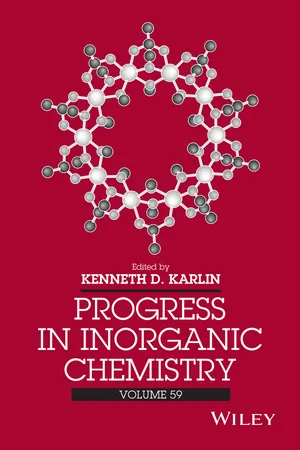
- English
- ePUB (mobile friendly)
- Available on iOS & Android
Progress in Inorganic Chemistry, Volume 59
About This Book
This series provides inorganic chemists and materials scientists with a forum for critical, authoritative evaluations of advances in every area of the discipline. Volume 59 continues to report recent advances with a significant, up-to-date selection of contributions by internationally-recognized researchers.
The chapters of this volume are devoted to the following topics:
•Iron Catalysis in Synthetic Chemistry
•A New Paradigm for Photodynamic Therapy Drug Design: Multifunctional, Supramolecular DNA Photomodification Agents Featuring Ru(II)/Os(II) Light Absorbers Coupled to Pt(II) or Rh(III) Bioactive Sites
•Selective Binding of Zn2+ Complexes to Non-Canonical Thymine or Uracil in DNA or RNA.
•Progress Toward the Electrocatalytic Production of Liquid Fuels from Carbon Dioxide
•Monomeric Dinitrosyl Iron Complexes: Synthesis and Reactivity
•Interactions of Nitrosoalkanes/arenes, Nitrosamines, Nitrosothiols, and Alkyl Nitrites with Metals
•Aminopyridine Iron and Manganese Complexes as Molecular Catalysts for Challenging Oxidative Transformations
Frequently asked questions
Information
Iron Catalysis in Synthetic Chemistry
- I. Introduction
- II. Addition Reactions
- A. Cycloadditions
- 1. The [2 + 2] Cycloaddition
- 2. The [3 + 2] Cycloaddition
- 3. The [2 + 2 + 2] Cycloaddition
- 4. The [4 + 2] Cycloaddition
- B. Cyclopropanation
- C. Aziridination and Aziridine Ring-Opening Reactions
- D. Carbometalation of C—C Unsaturated Bond
- E. Michael Addition
- F. Barbier-Type Reaction
- G. Kharasch Reaction
- A. Cycloadditions
- III. The C—C Bond Formations VIA C—H Functionalization
- A. The C—H Arylation
- 1. Direct Arylation With Organometallic Reagents
- 2. Direct Arylation With Aryl Halides
- B. The C—C Bond Formation Via Cross-Dehydrogenative Coupling
- 1. The CDC Between Two sp3 C—H Bonds
- 2. The CDC Between sp3 and sp2 C—H Bonds
- 3. The CDC Between sp3 and sp C—H Bonds
- C. The C—C Bond Formation via Cross-Decarboxylative Coupling
- D. The C—C Bond Formation via Alkene Insertion
- E. Oxidative Coupling of Two C—H Bonds
- A. The C—H Arylation
- IV. The C—H Bond Oxidation
- A. Hydroxylation
- B. Epoxidation
- C. cis-Dihydroxylation
- V. Cross-Coupling Reactions
- A. Alkenyl Derivatives as Coupling Partners
- B. Aryl Derivatives as Coupling Partners
- C. Alkyl Derivatives as Coupling Partners
- 1. Low-Valent Iron Complex in Cross-Coupling Reactions
- D. Acyl Derivatives as Coupling Partners
- E. Iron-Catalyzed C—O, C—S, and C—N Cross-Coupling Reaction
- F. Iron-Catalyzed Mizoraki–Heck Reaction
- G. Iron-Catalyzed Negishi Coupling Reaction
- H. Suzuki–Miyaura Coupling Reaction
- I. Sonogashira Reaction
- J. Mechanism of Cross-Coupling Reactions
- K. Hydrocarboxylation
- L. Enyne Cross-Coupling Reaction
- VI. Direct C—N Bond Formation VIA C—H Oxidation
- VII. Iron-Catalyzed Amination
- A. Allylic Aminations
- B. Intramolecular Allylic Amination
- VIII. Sulfoxidations and Synthesis of Sulfoximines, Sulfimides, and Sulfoximides
- A. Sulfoxidation
- B. Synthesis of Sulfoximines, Sulfimides, and Sulfoximides
- 1. Mechanism
- IX. Reduction Reactions
- A. Hydrosilylation of Alkenes
- B. Hydrosilylation of Aldehydes and Ketones
- C. Hydrogenation of C—C Unsaturated Bonds
- D. Hydrogenation of Ketones
- E. Hydrogenation of Imines
- F. Reduction of Nitroarene to Anilines
- G. Hydrogenation of Carbon Dioxide and Bicarbonate
- H. Amide Reduction
- I. Reductive Aminations
- X. Trifluoromethylation
- XI. Conclusion
- Acknowledgments
- Abbreviations ...
Table of contents
- Cover
- Advisory Board
- Title Page
- Copyright
- Chapter 1: Iron Catalysis in Synthetic Chemistry
- Chapter 2: A New Paradigm for Photodynamic Therapy Drug Design: Multifunctional, Supramolecular DNA Photomodification Agents Featuring Ru(II)/Os(II) Light Absorbers Coupled to Pt(II) or Rh(III) Bioactive Sites
- Chapter 3: Selective Binding of Zn2+ Complexes to Non-Canonical Thymine or Uracil in DNA or RNA
- Chapter 4: Progress Toward the Electrocatalytic Production of Liquid Fuels from Carbon Dioxide
- Chapter 5: Monomeric Dinitrosyl Iron Complexes: Synthesis and Reactivity
- Chapter 6: Interactions of Nitrosoalkanes/arenes, Nitrosamines, Nitrosothiols, and Alkyl Nitrites with Metals
- Chapter 7: Aminopyridine Iron and Manganese Complexes as Molecular Catalysts for Challenging Oxidative Transformations
- Subject Index
- Cumulative Index
- End User License Agreement